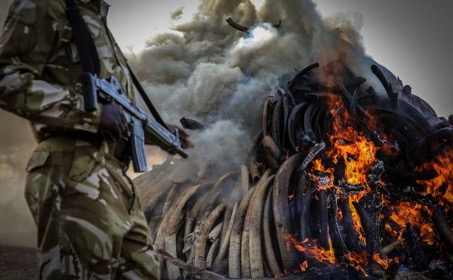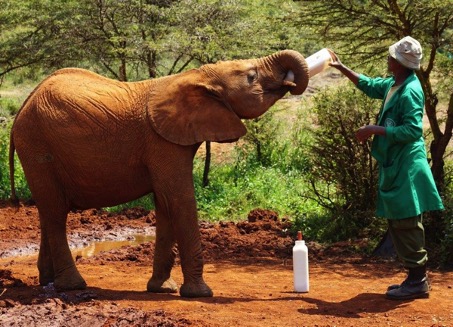Africa’s poaching wars
Poaching destroys Africa’s big animals for their valuable tusks and horns. To protect wildlife, a new, out-of-the-box thinking of conservation is needed.

In a nutshell
- Poaching is a multibillion-dollar illicit business in Africa
- The 1989 ban on ivory trade was practically nullified by rising demand
- Putting wildlife management into local hands has worked for Namibia
Poaching of elephants and rhinos in Africa has intensified in recent years. From the conservation point of view, this is a major issue. Less than half a million elephants are left in Africa, an estimated 61 percent fewer than in 1980. About 20,000 elephants were poached in 2014, and 100,000 between 2010 and 2012. Of the remaining 25,000 African rhinos, 1,300 were killed in 2015. Many park rangers have also fallen victim to ruthless and well-armed poacher bands.
Geopolitical threat
The other side of this ecological tragedy is the multibillion-dollar business that poaching has created for criminal organizations and terrorist groups. According to one study by the NGO Elephant Action League, elephant poaching in Kenya and related trafficking may provide up to 40 percent of the funding for al-Shabaab’s fighters in Somalia.
Boko Haram is thought to make money out of poaching in Cameroon. Other terrorist groupsthat rely on such income include Joseph Kony’s Lord’s Resistance Army in Uganda, the Mai-Mai in the Democratic Republic of the Congo (DRC), and Janjaweed in Sudan.
In this light, poaching suddenly takes on a geopolitical dimension, because these groups pose a regional threat. The link between ivory and violence is so strong that “white gold” is used as currency to buy weapons within criminal and terrorist networks.
There is no doubt that an international response is required. One logical venue for a decision is the Convention on International Trade in Endangered Species of Wild Fauna and Flora (CITES), which begins a two-week session in South Africa on September 24. Yet CITES signatories are divided about what to do.
Many African countries want a total ban on ivory trade, while others would prefer to regulate it tightly through the CITES Decision-Making Mechanism (DMM). These two positions have increasingly polarized the approach to wildlife protection. Unexpectedly, the European Union– a big donor to conservation in Africa – came out against a total ban in July.
Consumer demand
Demand for rhino horn comes mainly from its use in traditional Chinese medicine and its supposed properties as an aphrodisiac. It is also a status symbol in countries like Yemen, where the handles of traditional daggers are carved from horn. Its price reaches a staggering $60,000 per kilogram, more than platinum. Yet rhino horn is made of keratin, the same material as human nails, and can be harvested without killing animals. Tranquilized rhinos can be painlessly dehorned, and the horn will grow back. Ranchers in countries like South Africa (which accounts for 90 percent of the African rhino population) harvest rhino horns, which makes poaching even more pointless and tragic.
Ivory was simply part of the new commodities boom, and speculators piled up stocks in expectation of a quick killing.
Elephant tusks, on the other hand, can only be taken from dead animals. For traffickers, this makes killing preferable to waiting for natural deaths. Demand for “blood ivory” has been fueled by the appetite for traditional carvings in many cultures. The average black market price for ivory in China reached $2,100 per kilogram in 2014. Interestingly, the price halved to $973 a year later, according to Daniel Stiles, an expert on the Chinese ivory market.
Mr. Stiles claims the surge in Chinese ivory prices after 2007 was triggered by the global financial crisis, which encouraged a shift in speculative investments from stocks and real estate into commodities. Ivory was simply part of the new commodities boom, and speculators piled up stocks in expectation of a quick killing (in China, ivory prices have jumped from $750 a kilogram in 2010).
Over the past two years, however, consumer demand has probably declined. The major factors include China’s overall economic slowdown, a September 2015 announcement by President Xi Jinping that the ivory industry would be phased out, and an anti-corruption campaign that has caused sales of luxury items to plummet. Another reason for the recent price fall may be excess supply since poaching is still going strong.
Case for prohibition
The anti-poaching campaign’s biggest spectacle came on April 30, 2016, when 105 tons of ivory and 1.35 tons of rhino horn worth an estimated $170 million were burned on pyres at Nairobi National Park in Kenya. Kenyan President Uhuru Kenyatta was in attendance, along with his counterparts Ali Bongo of Gabon and Yoweri Museveni of Uganda. The idea was to send poachers and traffickers the message that ivory has no value unless it is attached to living elephants.
Rising demand in Asia nullified the effect of the 1989 ban.
In his keynote speech, Mr. Kenyatta called for a total stop to the ivory trade. This would go beyond the ban of international trade issued by CITES in 1989, which allowed some domestic markets to persist. This loophole is thought to let illegal trade in elephant tusks flourish, since smuggling from one domestic market to another is a simple matter given the levels of corruption in many countries, especially in East Asia.
Rising demand in Asia nullified the effect of the 1989 trade ban and led to an explosion of poaching. Under these conditions, permitting legal trade in any form will not work, according to the “prohibition view” championed by the United States, Kenya and many conservation groups.
Legal, regulated trade depends on controls and inspections that can easily be circumvented by corrupt officials. The existence of legal trade simply encourages the illegal variety, according to the prohibitionists, because it stimulates demand instead of discouraging consumers, and allows poached tusks to be “laundered” through legal channels.
Case for trade
Other experts maintain that the traditional approach to wildlife conservation, based on the prohibition of trade, can have perverse effects. Despite good intentions, bans and tusk burning will not eradicate illegal trade. Even worse, the creation of scarcity automatically elevates the price on the black market, providing huge incentives to organize poaching and smuggling networks. The dynamic is like that of the drug war, with corresponding levels of violence, and its outcome could be similar to U.S. experiment with Prohibition of alcohol in the 1920s and 1930s.
Opponents of a trade ban also point to peculiar features of the ivory market. Daniel Stiles claims that the “laundering effect” of the legal ivory trade has little effect in China because most sales of jewelry, chopsticks and other products made from ivory are already illegal. Only expensive carvings made from legally obtained ivory (largely from government stocks) are sold at 130 official outlets, which account for a fraction of the market.

In addition, prohibition does not resolve the fundamental problem of habitat conflict between man and elephant. It can even amplify that conflict. While many people have a benign picture of elephants, the presence of herds can be very damaging for human communities living near them, damaging crops, competing for water, and even killing people. Rural dwellers trying to cohabit with such difficult animals will naturally tend to become poachers, especially when they are poor.
Countries like Zimbabwe argue that the answer is a well-regulated trading system that would lower prices and provide revenue to the government. The latter, in turn, could be used to finance conservation efforts. A tax on final goods could also be imposed, both to curb demand and provide more funds for wildlife protection.
Tragedy of the commons
Poaching is an instance of a classic economics problem – the “tragedy of the commons,” or of individuals’ free access to shared resources. Just as with fishing on the open seas, in many parts of Africa elephants and rhinos – even in national parks – are an open-access resource. Those who want to extract value from this “non-appropriated” resource have an incentive to act quickly, leading to its rapid depletion. And as we have already seen, the potential monetary gains are very big.
Unless one introduces the concept of property, there is no incentive to manage such resources on a sustainable, long-term basis. Without ownership, even tightly regulated legal trade will not curb poaching. A combination of prohibition and nationalizing ownership of wildlife, as was adopted by Kenya in the 1970s, has not worked either. Instead, the country has lost more than two-thirds of its wildlife stock over the past four decades.
Private ownership
Ownership can take various forms. For individual private owners, there is always a cost-benefit analysis. Obviously, owners must bear costs, not only to maintain and manage the animals, but also to compensate their neighbors for crop damage. In return, they reap the benefits of commercial usage. This can range from selling horn obtained from humane dehorning of rhinos or the natural deaths of elephants, to safari or trophy hunting of selected animals (which can be used as a means of herd management). This activity can be easily monitored by ranchers and local communities, which would also stand to benefit from the resulting income.
Commercial use can pay for the protection and preservation of a natural resource.
Private appropriation of wildlife resources also requires a technology of ownership. The invention of barbed wire, for example, made the modern cattle industry feasible. From this standpoint, surveillance, tracking and tagging technologies have evolved considerably in recent decades. They are being used at private ranches in South Africa that have enabled the white rhino breed to recover since the 1960s. This shows that commercial use can pay for the protection and preservation of a natural resource, because owners have a financial incentive.
Institutions also matter. Property is not effective without enforcement, and serious fines and jail sentences are required to deter poaching on private and public ranges. The rule of law is crucial, which effectively rules out conservation in failed states.
Community ownership
Property rights do not have to be private. Common property is also a crucial strategy to empower local communities and change their incentives. As shown by Elinor Ostrom, the Nobel Prize winning economist, small communities around the world successfully manage environmental commons such as lakes, forests, pastures or irrigation systems – provided there are strong mechanisms of mutual control.
Namibia put wildlife management into local hands in the 1990s. The change radically altered ways of thinking. Poaching was no longer “stealing from the government,” but “stealing from my neighbors” – a violation of social norms. The country now has many private or communal conservancies. Hunting is allowed within certain limits (an elephant trophy can fetch $25,000, a fortune in poor rural areas.) Meat from killed animals is given back to the community.
For local communities, elephants are no longer a pest but an opportunity for development.
Not surprisingly, Namibia’s wildlife stock is increasing. With its growth, crop damage is also rising – but compensation is easier to organize thanks to community ownership and the revenue derived from it. Everyone understands “our animals” are a source of wealth. For local communities, elephants are no longer a pest but an opportunity for development to be managed and protected.
Scenarios
These alternatives will be debated in Johannesburg at the next CITES meeting. The dividing lines are already clear. Kenya and the 28 other members of the African Elephant Coalition (AEC) are pushing for a total ban. The southern African countries – particularly Namibia and Zimbabwe, both with growing elephant numbers – want some form of regulated ivory trade. Three scenarios can be foreseen.
Total ban
First would be a total ban on domestic and international trade. In effect, this would prevent any resource appropriation. The ban would be accompanied by more aggressive campaigns to discourage demand and combat poaching. But corruption and terrorist groups cannot be easily eradicated, and relative scarcity will simply incentivize criminal groups to keep poaching. Implementing total prohibition is unlikely in any case because Zimbabwe and Namibia strongly oppose this approach.
Regulated trade
The second option would be the introduction of tightly regulated trade, both domestic and international. As noted earlier, this approach requires an effective rule of law and strong property rights. In countries such as South Africa, with relatively sturdy institutions, this would not be a problem; revenue from commercial exploitation would contribute to national wealth and conservation.
However, in failed states such as the DRC, corrupt officials and criminal networks will find the illegal trade to be more profitable in the short term. This scenario is also unlikely, given the strong prohibitionist stance of the U.S. and the AEC.
Little change
The most likely outcome is a failure to agree on any single approach. This means continuing the status quo, with perhaps more money channeled to ranger training and equipment, customs controls and consumer awareness campaigns. It is hard to see this putting a stop to the poaching wars. The Southern African nations that have chosen appropriation will conserve their wildlife but will be deprived of the revenue that regulated international trade would provide. Smuggling will thrive from countries that tolerate domestic trade, while scarcity will keep poachers active in countries with bans.






